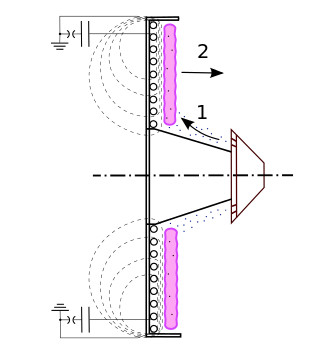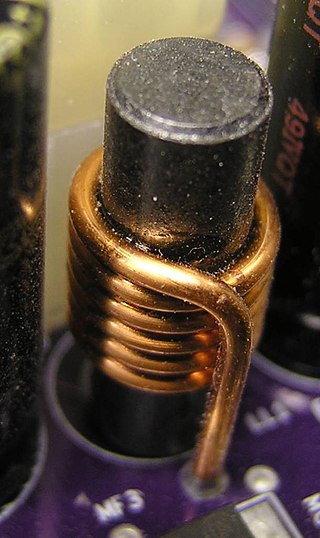
Electricity is the set of physical phenomena associated with the presence and motion of matter possessing an electric charge. Electricity is related to magnetism, both being part of the phenomenon of electromagnetism, as described by Maxwell's equations. Common phenomena are related to electricity, including lightning, static electricity, electric heating, electric discharges and many others.

A pulsed inductive thruster (PIT) is a form of ion thruster, used in spacecraft propulsion. It is a plasma propulsion engine using perpendicular electric and magnetic fields to accelerate a propellant with no electrode.

The coulomb (symbol: C) is the unit of electric charge in the International System of Units (SI). In the present version of the SI it is equal to the electric charge delivered by a 1 ampere constant current in 1 second and to 5×1027/801088317 elementary charges, e, (about 6.241509×1018e).

In physical chemistry, the Faraday constant (symbol F, sometimes stylized as ℱ) is a physical constant defined as the quotient of the total electric charge (q) by the amount (n) of elementary charge carriers in any given sample of matter: F = q/n; it is expressed in units of coulombs per mole (C/mol). As such, it represents the "molar elementary charge", i.e., the electric charge of one mole of elementary carriers (e.g., protons). It is named after the English scientist Michael Faraday. Since the 2019 redefinition of SI base units, the Faraday constant has an exactly defined value, the product of the elementary charge (e, in coulombs) and the Avogadro constant (NA, in reciprocal moles):

The henry is the unit of electrical inductance in the International System of Units (SI). If a current of 1 ampere flowing through a coil produces flux linkage of 1 weber turn, that coil has a self inductance of 1 henry. The unit is named after Joseph Henry (1797–1878), the American scientist who discovered electromagnetic induction independently of and at about the same time as Michael Faraday (1791–1867) in England.

The farad (symbol: F) is the unit of electrical capacitance, the ability of a body to store an electrical charge, in the International System of Units (SI), equivalent to 1 coulomb per volt (C/V). It is named after the English physicist Michael Faraday (1791–1867). In SI base units 1 F = 1 kg−1⋅m−2⋅s4⋅A2.
Faraday's law may refer to the following:
FF, Ff, fF or ff may refer to:
In physics, the weber is the unit of magnetic flux in the International System of Units (SI). The unit is derived from the relationship 1 Wb = 1 V⋅s (volt-second). A magnetic flux density of 1 Wb/m2 is one tesla.
Tesla most commonly refers to:
Michael Faraday was an early 19th-century British scientist.
F90 or F-90 may refer to:
F is the sixth letter of the Latin alphabet.
The Faraday Prize, named after British scientist Michael Faraday, can refer to:
This page is based on this
Wikipedia article Text is available under the
CC BY-SA 4.0 license; additional terms may apply.
Images, videos and audio are available under their respective licenses.





